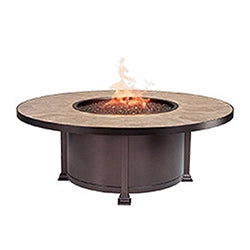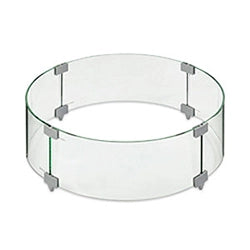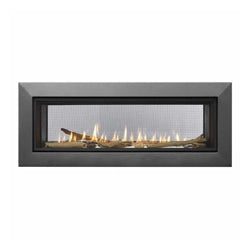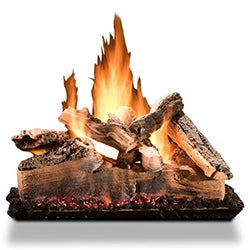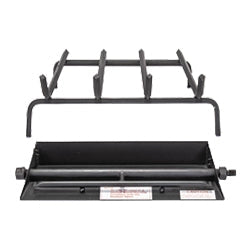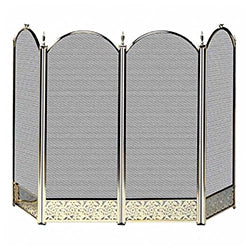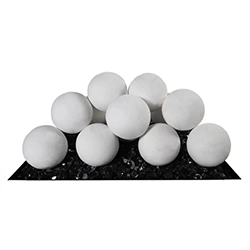Fire pit projects have a tendency to get exceedingly technical exceptionally fast, and for good reason. There are a lot of parts and components that go into a fire pit, and just as many outside considerations (such as technical setups and design choices) that need to be taken when selecting your new fire feature. We understand that it can be difficult to know where to start, so we’re here to walk you through the most important aspects you’ll need to focus on in choosing the perfect fire pit for your space.
1. How much heat do you need?
The amount of heat you want your fire pit to produce will depend on the size of the groups you plan on having gather ‘round, and that heat output dictates the size of the fire ring or burner your fire pit needs.
Pick Your BTUs
 Fire Pit Art has a variety of fire pit sizes, adding a range to the BTUs they offer.
Fire Pit Art has a variety of fire pit sizes, adding a range to the BTUs they offer.
In our Guide to BTUs blog article we talk about the amount of heat we recommend based on the square footage that needs warming. For those comfy two to four person gatherings, 40k-90k BTUs of heat will usually do the trick. If you’re looking to fit a few couples and all their kids, though, you’ll be better off with 150k BTUs or more (we always prefer warmer, if we’re being honest).
To-Do: If you’re not quite sure on how much heat you need, you can get a rough estimate from Calculator.net. Just make sure to bump up your number to account for wind chill, as this tool is designed more for use with indoor fireplaces.
Select the Corresponding Burner
 This 18” Stainless Steel Fire Ring by Starfire Designs offers up to 125k BTUs of heat.
This 18” Stainless Steel Fire Ring by Starfire Designs offers up to 125k BTUs of heat.
Once you have an idea of how many BTUs you want, you’ll need to select the corresponding fire ring or burner. These burners, such as our Starfire Designs burners, pair with your fuel to determine your heat output. If you select a fire ring that offers up to 90k BTUs, such as our 12” Fire Ring, that’s the max heat you’re going to get. If you’re looking for 150k BTUs of heat, you’re going to need a larger burner.
To-Do: With your BTU selected, browse through our selection of fire rings and burners to find the size that will provide the heat you and your guests crave.
The size of your burner will highly influence the size of your fire pit, since your fire pit at minimum needs to be able to house your fire ring. When we build fire pits, we put at least a 6” clearance between the edge of the burner and the edge of the fire pit. If you decide you need 125k BTUs, which is around an 18” burner, you’ll need to pair it with a 24” burner pan to hold your fire media--such as our fire glass--up and allow air flow below. So, in this example, we’d be looking at a 24” or larger fire pit. But that doesn’t take into account fuel type and layout (we’ll cover those next).
2. What fuel do you plan to use?
The fuel you intend to use will change the other considerations you’ll need to make when deciding on your fire pit size. Let’s go through the three most common types of fire pit fuels: hard line gas (natural gas and propane), liquid propane tanks, and wood.
Hard Line Gas
 The Stahl Gas Fire Pit sits low at 12” tall, making it an option for hard line gas fuel.
The Stahl Gas Fire Pit sits low at 12” tall, making it an option for hard line gas fuel.
Most commercial buildings and track homes have a connection to a natural gas line, which is commonly connected to a meter on the exterior of your building. Whereas, older homes and residences that sit on more land may have a large propane gas tank situated on their property.
If this is the fuel you’re looking to use, you’re going to need to consider the distance from your source to the desired location of your fire pit. The number of BTUs you’ll get from a hard line installation depend on the diameter of your fuel line and the distance the gas must travel to your fire pit. Based on those two aspects, you can reach an impressive amount of heat! For more details on how and why these impact your BTUs, check out our Guide to BTUs blog article.
To-Do: If you’re going to use hard line gas, find a local installer who can get you information on what your existing pipe size is, and whether they recommend running a new dedicated line for your fire pit. They can clarify for you what your max BTUs will be based on your fuel line.
Liquid Propane Tank
 Real Flame’s Ventura Square Chat Height Gas Fire Table easily hides an LPT in it’s base.
Real Flame’s Ventura Square Chat Height Gas Fire Table easily hides an LPT in it’s base.
Frequently used for portable BBQ grills, liquid propane tanks are often referred to as LPTs, and are sold in 20lb re-fillable tanks. These are great for spaces that you don’t have the means to run a hard line to, and it’s easy to pick up a new tank at the local grocery store (you just exchange your empty tank and pay a fee for the new one, the gas company will re-fill your old tank and sell it to someone else).
There are a few things to keep in mind if you want to use this fuel type. If you’re hoping to hide away your propane tank, you’ll need to make sure your fire pit is tall enough (we recommend 22” tall or higher), or else you’ll need to invest in a special horizontal tank (which is not as readily exchanged). Alternatively, you can purchase an LPT cover, which often doubles as a side table that slips overtop your tank. Something else to note; most fire pits will only fit one LPT, and a single tank maxes out at around 90k BTUs of heat. So, if you want more heat than that, you’ll need to make sure you can fit some extra tanks and their connection hoses.
Wood
 Fire Pit Art’s Bella Vita Fire Pit has both a gas and wood fuel option.
Fire Pit Art’s Bella Vita Fire Pit has both a gas and wood fuel option.
Wood fires always provide the most heat, and since they’re fueled by whatever choice cedar, oak, or miscellaneous backyard scrap wood you have on hand, there isn’t much else that goes into this fuel type. These fires give you the freedom to place your fire pit in any space (so long as it’s a safe distance from any buildings), and don’t have a BTU cap, so they are a very versatile and powerful option.
3. What look suits your space?
Once you know how many BTUs you need to keep everyone warm, and what fuel you want to use, it’s time to start considering your fire pit shape, material, and seating arrangement. The technical components have all been considered, so now it’s time to enjoy the design selection.
Shapes & Material
 Vin de Flame uses genuine wine barrels for their impressively authentic Reserve Fire Pit Table.
Vin de Flame uses genuine wine barrels for their impressively authentic Reserve Fire Pit Table.
If you have a long and narrow space, a rectangular fire pit will suit your area best. However, if you’ve got ample room, a round or square fire pit will also look highly welcoming. And if you have more backyard than you know what to do with, splurge on a large fire pit that will leave an impression on your guests, such as our 60” Cono Moreno, which packs a whopping 150k BTUs of inviting warmth.
For as many shapes that fire pits are available in (through primarily just the three described above), there is a seemingly endless number of materials that can be used. So many, in fact, that we wrote a whole article about the most popular materials: concrete, copper, steel, and tile. Each of these materials have their own unique traits and quirks when it comes to functionality, as well as appearance. If you don’t already have a material in mind, we highly recommend taking a few minutes to read through our Guide to Fire Pit Materials to see what sorts of traits you’re leaning towards for your new fire pit’s design.
Comfortable Seating
 Four armchairs is perfect for this round Charleston Gas Fire Pit by Agio.
Four armchairs is perfect for this round Charleston Gas Fire Pit by Agio.
With the technical requirements determined, and your fire pit shape and material selected, you must choose how much seating you want to provide, as well as how you want to distribute it.
To complement your rectangular, or oversized square, fire pit we recommend a loveseat or sofa with some armchairs on either end to entice everyone to gather ‘round (or you can throw a sectional in to really create a welcoming environment). Conversely, we find that round fire pits look best with single chairs collected around them, reminiscent of a campfire and its more intimate atmospheres.
If you’re set on having an incredibly plush sofa to fall into to create your at-home oasis, you definitely want to consider a rectangular fire pit. Don’t be afraid to mix things up, just make sure to leave enough leg room to keep you and your guests' knees safe.
We hope that these steps guide you in picking the right fire pit for your design preferences and your space’s needs. If you have any technical questions, or want some suggestions on what some of our best options are for your unique requirements, feel free to contact our friendly and knowledgeable staff by filling out this simple form.
Main Image: Our 10’ Copper Spartan Fire Pit requires a lot of space, but creates a powerful experience.







